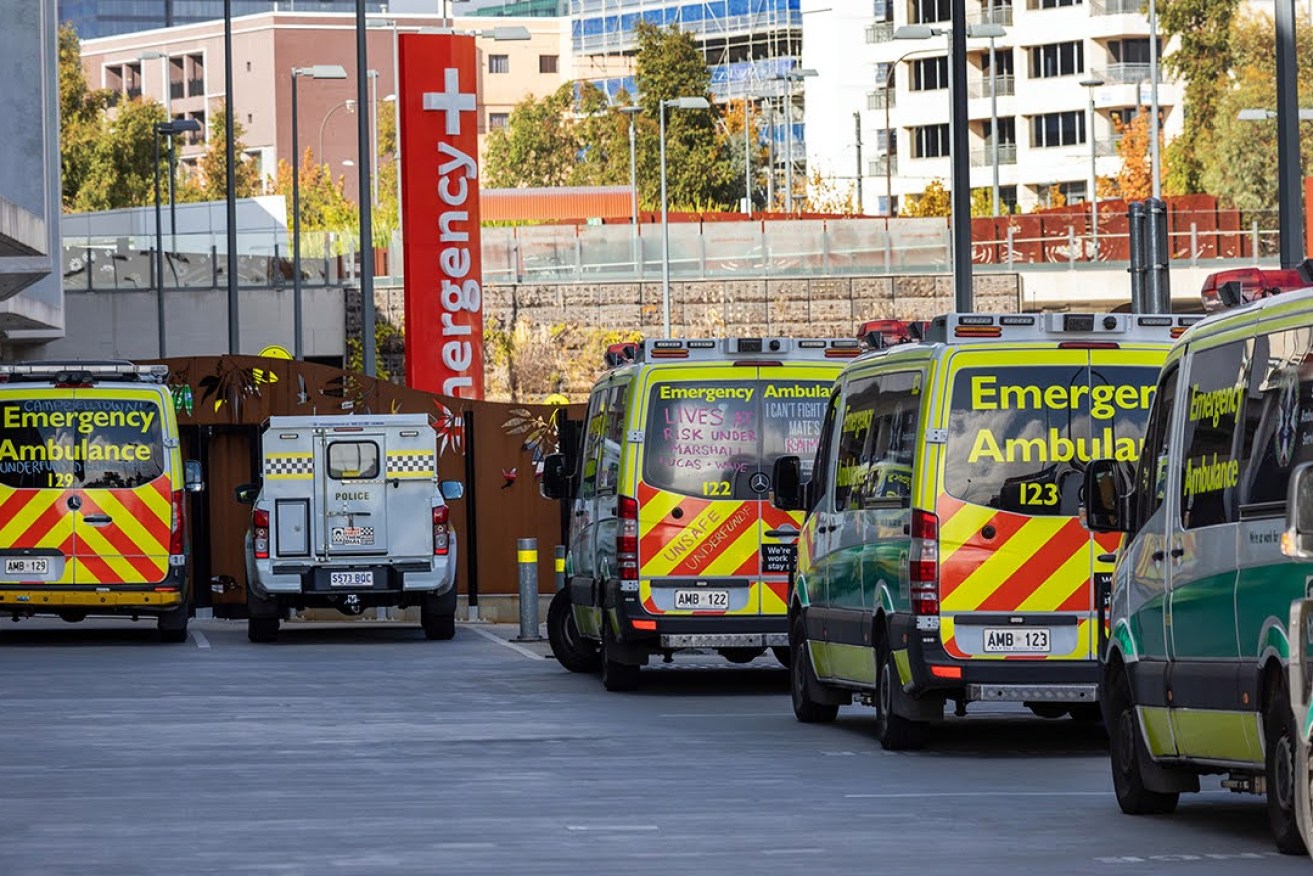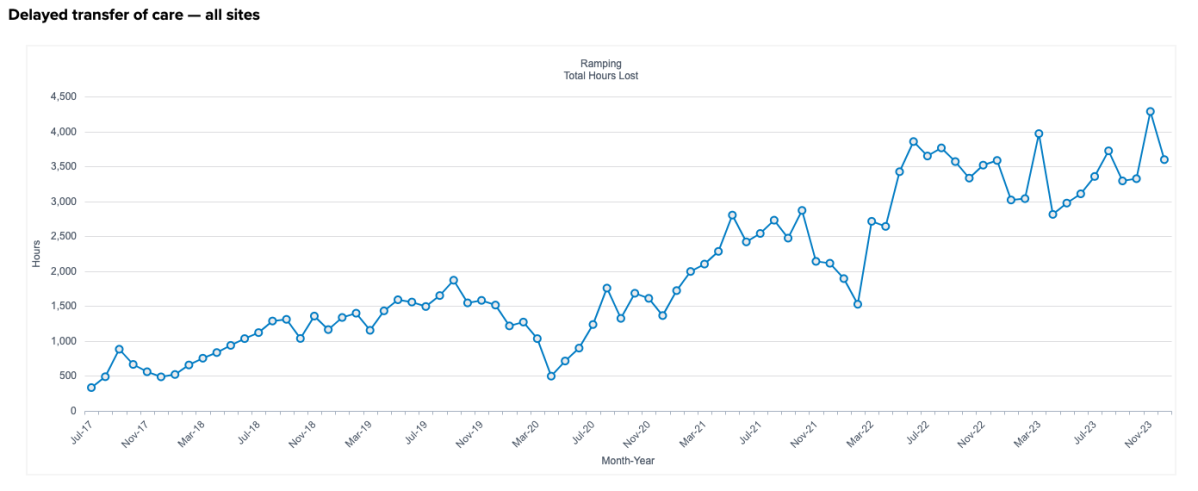Adelaide man died waiting 10 hours for ambulance
SA Health has confirmed that a 54-year-old man died at home after waiting more than 10 hours for an ambulance because of ramping outside full emergency departments.


Photo: Tony Lewis/InDaily
The Ambulance Employees Association revealed details of the man’s death on Thursday afternoon, saying it reinforced the risks of paramedics being unable to offload patients into crowded emergency departments and respond to urgent calls for help.
The union said that on Wednesday December 27, all Adelaide metropolitan hospital EDs were on Code White, the highest rating above capacity, with “significant ramping”.
“Tragically on that night a 54-year-old male in Hectorville passed away after waiting over 10 hours for an ambulance,” the union said.
“The AEA understands that the 000 call was for abdominal pain and vomiting and the case was initially triaged as an Urgent Priority 5 requiring an ambulance to attend within 60 minutes.
“Due to significant ramping, ambulances were stuck at hospitals instead of being available for the community. This led to long delays in ambulance responses, and by the time an ambulance arrived for this patient, he had passed away.”
SAAS chief executive Rob Elliott this afternoon confirmed the incident occurred, saying there was “an extended delay which had a tragic outcome”.
The incident is now under review.
Elliott said the hospital system was on December 27 experiencing “extremely high triple zero demand and lots of significant ramping as well”.
He said the patient was categorised as a priority five for 10 hours, until a call was received just before 5am that the patient had deteriorated.
After that call, the patient was “immediately” upgraded to a priority one and an ambulance arrived within four minutes.
“We did stay in contact with the triple zero caller for this case… and we had contact with them through the night,” Elliott said.
“When they rang us back to advise us that the patient had deteriorated, the case was upgraded to priority one and we arrived within four minutes.”
Asked why they had to wait until the end of the 10 hours, Elliott said: “We had to prioritise the higher acuity calls that we’re receiving and some of our lower acuity patients did experience delays.”
Asked if he was confident the patient was correctly assessed as a priority five case, Elliott said: “We are undertaking a review of the case and the circumstances of the case. That will be subject to the review.”
He later added: “This is an absolutely tragic outcome – our hearts go out to them (the family).
“This is not the standard of service that we want to provide.”
Asked if the public should have confidence in calling for an ambulance rather than taking a taxi to hospital, Elliott said: “I think people should get some health professional advice and the best way to do that is actually ring triple zero and talk to one of our call takers.
“There are very very limited and restricted circumstances where some of our healthcare professional paramedics who do specialist training in telephone triage may advise that an alternate form of transport might be the most appropriate way to move to hospital.
“So I would prefer people had confidence in SA Ambulance, ring triple zero, have that conversation and get really good advice from an expert clinician about other alternate options that might be available where an ambulance isn’t.”
Asked if this person would still be alive if they called a taxi or Uber, Elliott said: “That’s not something I can comment on.”
On 27 Dec there was significant ramping across Adelaide. Tragically a 54 yo male in Hectorville passed away after waiting >10hrs for an ambulance to arrive. This highlights the upmost importance of EDs clearing ramped ambulances to respond to the community ?.
? RAH: 10pm 27/12 pic.twitter.com/PrlKPwf3HQ— Ambulance Employees Association (SA) (@aeasa1981) January 4, 2024
The union said that its members reported that on December 27 and other days, “waiting room patients were prioritised into the Emergency Department over patients in ramped ambulances, leading to some crews being ramped and unable to respond for over 7 hours and leaving our community at risk”.
The union said it had given details of the incident to an inquiry into claims that hospital staff were pressured to prioritise and treat ambulance patients over those already inside emergency departments in a bid to reduce ramping numbers.
SA Health CEO Robyn Lawrence today said that inquiry – led by senior clinicians Bill Griggs and Keith McNeil – would be expanding to examine the AEA’s claims. The review was initially expected to be handed down at the end of next week.
“We’re taking these allegations of both the medical staff and our paramedic staff very seriously and we’re looking to get to the bottom of it,” Lawrence said.
“Our expectation.. is that patients are triaged at hospitals and they are seen in order of priority.”
Ramping reached a new state record in November, with ambulances and patients spending 4285 hours – equivalent to 178 days – parked outside hospitals.
The Malinauskas Government, which won the 2022 state election with a key promise to “fix the ramping crisis”, set up the review on December 7 to investigate allegations by South Australian Salaried Medical Officers Association (SASMOA) president David Pope.
Pope, an emergency medicine specialist at the Lyell McEwin Hospital, posted on social media on December 6 that emergency department clinicians were being “intimidated to off load ambulance pts (patients) when there are sicker and more urgent pts in the waiting room”.
“The repeated calls from hospital managers demanding ambulance off-load counter to other patient’s urgent clinical needs are so distressing,” he said.
“We back up our nurses but they still receive call after call. No clinician should be subject to this.”
The AEA today disputed those claims.
“Despite these recent claims, the levels of ramping and cases such as this tragic death demonstrate that this is not the case, and that patients in the community are being put at risk due to delayed transfers of care and ambulances not being released from hospital ramps,” it said.
The union, which played a prominent part in Labor’s ramping election campaign against the former Marshall Liberal government, said ambulance response times had improved steadily since March 2022 but had “recently started to decline again and will not improve further until we see a significant reduction in ramping”.
AEA industrial officer Josh Karpowicz said the Hectorville man’s death was a “stark reminder that when ambulances are ramped at hospitals, patients waiting for help in the community are left without care for unacceptably and dangerously long periods of time”.
“Ramping takes ambulances off-road and puts patients at risk of deterioration in an environment where there is no one available to help them,” he said.
SA Health CEO Lawrence said the AEA’s allegations were “completely the opposite” of SASMOA’s.
“As a result of this, the reviewers… have been asked to expand their review to consider both of these sets of allegations in response to government,” Lawrence said.
Shortly before today’s press conference, SA Health released “transfer of care data” – or ramping figures – for December.
It said the 3,595 hours recorded – equivalent to 149 days – was down 16 per cent on November, despite hospital presentations rising by 2.2 per cent.

Ramping decline in December after reaching a record high in November. Image: SA Health
It also said that Priority One ambulance times for December were the best for three years.
Opposition health spokesperson Ashton Hurn said: “The Labor Government has a fundamental responsibility to ensure that the sickest patients needing urgent care are given the highest priority.”
She said the ambulance union’s revelations of the Hectorville man’s death showed “it is now clear that both doctors and paramedics lack confidence in the health system under Labor delivering that priority”.
“The lives of South Australians are more important than resorting to any sort of questionable tactics to desperately lower ramping numbers,” she said in a statement.
“We support expert clinicians making decisions about how patients are clinically prioritised in our hospitals – with the patient, not political promises, at the centre.”
Health Minister Chris Picton is currently on paternity leave and unavailable for comment.




